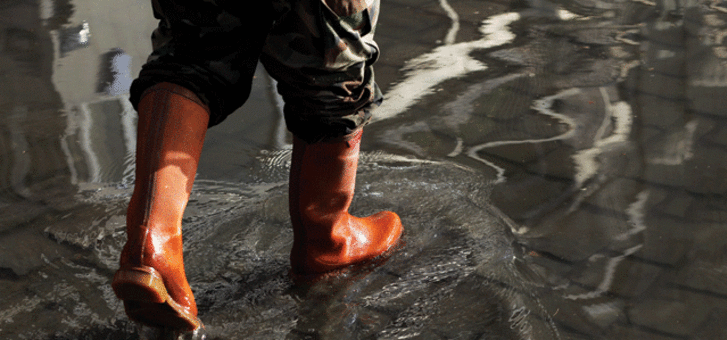After a chance meeting of mutual friends, I was introduced to Tim and Sonia in a restaurant in central Toowoomba, Queensland, eight days before their home was washed away. The restaurant was a few hundred metres from where some of the most dramatic TV footage of Toowoomba under flood was recorded on January 10.
A couple of weeks later, I visited Tim and Sonia Fittkau in their “new” home. Their old home had been flooded, then destroyed; two of their neighbours were still listed as “missing” and Tim had helped rescue others.
Tim, Sonia and their three young girls had been living at Postmans Ridge in the Lockyer Valley, just below the Toowoomba range, for three years. It was their “dream block,” with a house they’d almost finished renovating, which backed onto a creek that hadn’t flooded in living memory—they’d checked—even checking with neighbours as to where the water had come up to in the 1974 flood.“It’s something you never imagine happening to you,” says Tim. “You read of other people going through it but never imagine it for yourself.”
On Thursday, January 6, extremely heavy rain in the Toowoomba region resulted in about five centimetres of water through the house.
“The old lady across the road said it had never been so high before,” says Tim. “And as we had all of the carpets wet, the insurance company paid for us to stay in a Toowoomba motel while it was fixed.”
Tim and his brother-in-law, Gary, went back down the following Monday to begin to make minor repairs before the insurance assessor came.
“That morning it was pouring rain for three hours,” Tim recalls, “and for half-an-hour of that you couldn’t see even 20 metres in front of you, it was that heavy.”
Soon the creek was rising again, and by midday it was inside the house. “As the water kept rising, we began to think we should lift more things, because we didn’t know how high it was going to come. By that time, water was also flowing through my workshop. I had eight cars I had been working on for people, and I was pretty worried about them.”
The water was already knee-deep in the workshop. Tim climbed through a window and ran to the closest car. “It was then I saw my work car float into the front of the shed. I thought, ‘OK, this is getting pretty bad.’"
“Gary moved his car higher up the driveway. I saw that the water was rising—it looked like about a metre at a time. By then, Gary was yelling to me to ‘Get out of there!’ so I left the other cars and pushed as fast as I could through what was now waist-deep water on the highest point of our block.”
Safely on higher ground, they next watched the vehicles float away one by one. But then they noticed their neighbours trying to get away from the water rising through their house, so they went to help.
“One was in a four-wheel mobility scooter,” Tim explains. “I told Gary to get in his car and bash the fence down because we had to get him through somehow. He reversed into the fence and knocked it down.”
Gary drove his car into the water and three of them dragged the neighbour through the water to the car. “In about 80 metres, we had to stop three or four times in thigh-deep water, but we got him."
“I went back to help two others, one on each arm. We got about 10 metres from where the fence was and I slipped over. As I regained my footing, the force of the water pulled both of them out of my grip. I turned around and just watched them float away. But it was enough; they washed into a tree, where they were wedged.”
Tim and the others waited for the tide to subside, which, he says, lasted at its peak for about 15 minutes. When the water fell, they threw a rope to their stranded neighbours and completed their rescue.
Half-an-hour later, all that was left of Tim’s house was two bare concrete slabs. “While we’d been rescuing the neighbours, I’d glimpsed what was happening at our place, but the last I saw was water above the guttering, then I saw the roof just float off.”
Community spirit
People banded together to help Queensland get back on its feet again after the flood.
- They included:
- Volunteers who worked tirelessly to restore normality.
- Tradespeople who donated time and expertise.
- Members of the wider community who united spiritually.
- People from across Australia and the world who donated to the Premier’s Disaster Relief Appeal.
- Counselling and crisis lines that were open to deal with stress, promoting rapid recovery.
- Organisations like Red Cross, ADRA and The Salvation Army who provided moral and practical support.
Meanwhile, Sonia says, she was “stressing.” Tim had lost his phone in escaping the rising water and was out of contact. “I was mentally preparing myself for more water through our house,” Sonia says, “But then I got onto Facebook and saw what was happening downtown in Toowoomba.”
As soon as he could, Tim phoned and let Sonia know he was safe, but that the house was gone. It was their only contact until Tim made it to Toowoomba at 10.30 that night.
Then, according to Tim and Sonia, their family and church stepped in to help. Sonia’s sisters fielded phone calls and offers of help, as well as making sure they had food and clothes. “Our church was absolutely amazing,” adds Tim.
Their church is the Glenvale Seventh-day Adventist Church in Toowoomba, but they have been contacted by churches around Australia.
“I said to Sonia that we should keep a list so we can thank the many people who’ve helped, but we’ve been overwhelmed [with offers].” They’ve received so much that they’ve passed a lot on to others.
Sonia says their two youngest girls, Anna, two, and Mickayla, four months, have felt the disruption and stress in the family but it is three-and-a-half-year-old Katie who’s been most affected. “She realises the new swing she got for Christmas is gone, our house is gone and everything in it is gone,” Sonia reflects. “It hit her bad, but they’re starting to settle.”
Some of the mothers who were wanting to help asked about specific, familiar things they might be able to find for the girls, which, Sonia says, has been a big help. Says Tim, picking up the story. “The first night we stayed in this house, which was completely set up using things people have given us, we brought the girls in for the first time. Katie went into her room and saw a ‘Dora the Explorer’ doona and a brand new dress for church, and I was watching her. It brought tears to realise that everything she is familiar with has gone as well. But it isn’t just us who are going through it.”
Sonia says she most regrets losing the girls’ baby books, while Tim misses his shed. “We’re here for six months, which gives time to decide what we’ll do next,” says Sonia. “And Katie and Anna are excited that we can get a new house. We’re just ‘borrowing’ this one, they say.”
Rebuilding
Floods in several Australian states, Cyclone Yasi, Perth bushfires and the Christchurch earthquake have significantly damaged property, lives and livelihoods. Here are some practical tips on how to rebuild:
- Re-establish old routines as soon as you can.
- Don’t be afraid to seek help.
- Have professionals check that your house is safe.
- Replacement is usually cheaper than restoration.
- Accept comfort from strangers as well as from family, friends and God.
So, for a young family for whom faith is important, how does such a devastating experience affect what or how they believe? “Going through it all has strengthened my relationship with God,” says Tim. “For us, it’s been a process of counting our blessings—to use the words of the old hymn. While it challenges your faith in some areas, it also gives you endurance, realising that we can go through these kinds of things.”
“And,” adds Sonia, “as we were watching the death toll climb, we were thinking, ‘Yeah, we lost our house, but what’s a house [by comparison]?’ And like I said, the support we’ve had from our church—I couldn’t imagine what it would be like without that.”





